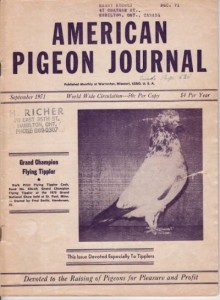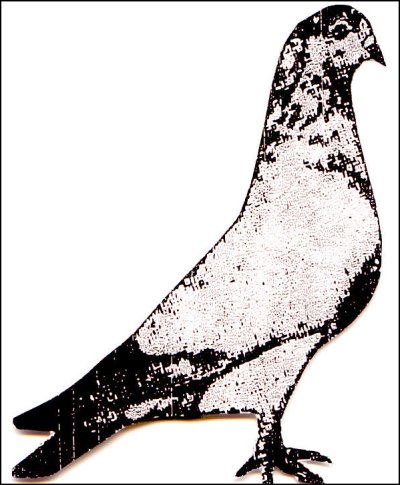By ROBERT B. FUNK. President, Hialeah, Fla. [Click Here For PDF Version]
American Pigeon Journal, 1971
Much has been said about the origin of this bird and how it obtained its name. We know that it is a manufactured breed and, from its size, appearance and characteristics, that it is basically from the tumbler family. If we had tumblers prior to Tipplers, then it is sound logic that the name Tippler came from breeding the tumbling out of the bird. The first offspring had, and sometimes still do have, a tendency to “tip up” in their flying.
As a matter of fact, I recently lost, through old age, a bronze mottled cock that, in his old age, developed a single complete roll, This is the only bird I have ever owned in Tipplers to do this since 1932. The bird’s ancestry, through pedigree, can be traced back to the 1920’s imports of English tipplers into Canada. I have never owned Rollers or tumblers, per se.
As in colour genes, this tumbling aspect of the bird can only be classified as a “throw back” quality. The ancient adage in the Flying Tippler hobby is to breed best flyer to best flyer, never to colour or body style. It is for this reason that many of the old die-hards like myself seriously challenge any show standard for the English Flying Tippler.
Again, as a matter of fact, I have a very productive AOC hen that has within the past year and a half given me Light Prints, Dun prints, several AOC’s, one red print, one red mottle and a blue smut. I have not had a red bird hatch in my loft in half dozen years, all of them lost or disposed of. I have never had a blue smut cock in my loft, only hens, and I have not had a silver barred cock since the 1950s, or late 1940s. So if you breed best flyer to best flyer, the tippler pigeon can afford you any combination of surprises. One loft in Canada, in the 30s and 40s kept nothing but yellow and red marked birds. Another, nothing but the extreme light prints. Both lofts had their distinction in color and fair flyers, but never the record setting times of the men from which the original stock came.
It is a challenge for a breeder to breed a handsome bird to an ugly one, just because they both fly well, but this is the name of the game, flying tipplers.
There are significant drawbacks in breeding especially to the person who must limit the number of birds he keeps. On one hand, certain families of birds within his loft breed better than others, certain ones fly better than others. Also the wing action of all the birds in your kit should be as close as it can. This comes from family. Witness the “team of horses”, brothers pull well together. Witness the nest mates, the two, regardless of sex, when young, make a better flying kit. But you need three birds to fly in competition and this is the ringer – to get three pairs of breeders to breed you three sets of youngsters, off the nest at the same time, and from the same good flying and good wing action family.
Why? This, first of all make for uniformity in wing action. It makes for uniformity in feather moult. It gives you a cock kit and a hen kit, because you are not going to break any records, when the birds mature with mixed sex kits. As stock fly yes, if your loft is basically of good breeding.
The drawback, in the main, comes from the breeder who has perfected a kit that has set a record and wishes to keep up the good work. His family lines “click” and then fall back. You cannot inbreed and line breed too long a time without certain flaws in the birds becoming pre-dominant. When you try to introduce new blood into your champion line, as good as the new line may be, you are again an experimental breeder. You are starting from scratch.
I have entitled this article The English Flying Tippler for that is what the Flying Tippler is, a British concoction and beautiful that it is. Many families, or better, strains, have been developed in England. Take the Billingham blacks for instance. Sam Billingham developed a basic black tippler with some white markings. Sam set a record but Sam’s blacks could not cross with any degree of record setting success. Their flight pattern was wild compared to the “butterfly wing action” of the birds from Doug Prud’homme and Nelson Balmer of Canada who, in part, obtained their bloodlines from Storey of England. The Storey bird for your information, is the one adopted as the trademark of the Flying Tippler Association of America and has for years appeared on the club’s letterheads.
Again, since feathers are all important in helping the bird fly, breeding of feathers so the speak, becomes all important. The broader the main flights are the better. Diet will not bring you broad flight feathers but it will give you hard quill. Hard quill is essential. You can test the quill of your birds with your thumb nail. If it is soft, the diet is off. if it is hard, and the flights are broad, you are okay in the feather business. Of course, lice and pigeon flies will eat at the feathering of your birds, so they must be bug free. If lice eat at the feathering they will destroy it, and you will lose a year until remoult, in which time you no doubt have lost a good flyer.
There are legends in the flight of the tippler, but all of them make good common sense. Witness the following:
If your perfectly bred kit is in moult unison you will hear a “whistle” of the wings as they fly near in their training. When the “whistle” stops, the kit is feather ready. If one bird in your kit has a feather problem he can drag the kit down. Also you can watch the tails of the birds in the kit. If the kit rakes closeby enough to see the tail and if it appears tight together, they are still flight minded. If the tail of one or all of the kit birds begins to spread, they are in dropping mind. They want to come in. It is time to toss your droppers if in training. You have had it if trying for a record time.
While good feather, as explained, is most important , the physical condition of your birds, naturally, is important to a goof flying kit. You have problems, because, the basic concept of a tippler is a wedged shaped bird, yet too deep a keel will tend to give you too heavy a bird. Shallow keel, good flyer, is part of it. There are many variations of feeding the kit in training and build up for a long time fly attempt. I will not attempt here to dwell on feeding in this article. The idea is to get your birds in good health with proper diet and regular exercise. Among the descriptive legends is the saying that a bird in good condition, when held in the hand, should feel alike an empty can, hard, firm and light. There again is your challenge, to get note one, not two, but three ore more birds in this condition. Another old tale is that of the length of the tail in respect to the length of the primary flights. I personally have only seen one “clan” of tipplers so constructed. There may be more but the owner of this clan has never made flying distinction. Yet, for what it is worth, one concept is that primary flights should reach to the tip end of the tail. The idea being the longer the wing, or wider the wing span, the greater the air buoyancy. You van take that for what it is worth, but as I have said before, there is a degree of common sense here. If the tip of the primaries is an inch ore more shorter than the length of the tail your bird is too cobby to be a good flyer, generally speaking.
The hallmark of a good breeder-flyer is a person who, over the years, can continue to develop race winning kits. He does not need to be a record breaker one on top of the other. If he is consistently better than the rest of the club, on the average, year after year, he is a very accomplished English Flying Tippler fancier. I have in mind specifically the late Nelson A. Balmer and the late Douglass Prud’homme, both of Toronto, Canada. These men were the greats of their time. I deem it a great honour to have known them both through the mails and Mr. Balmer through his personal visits to my loft.


